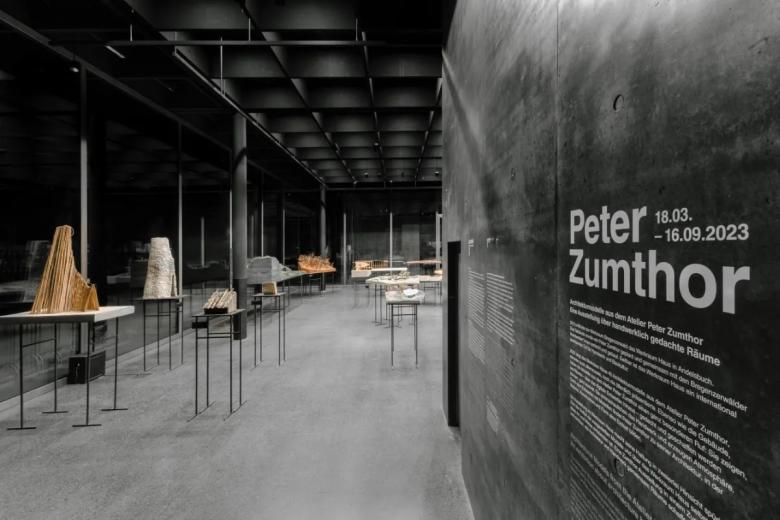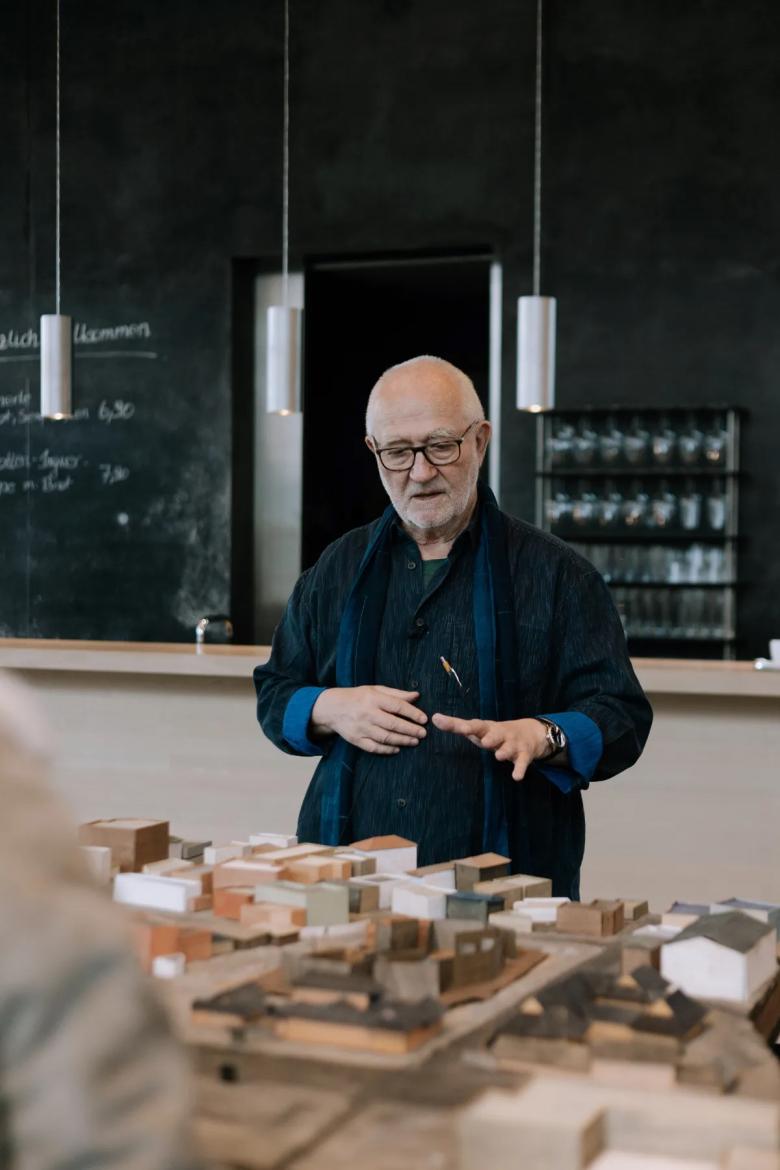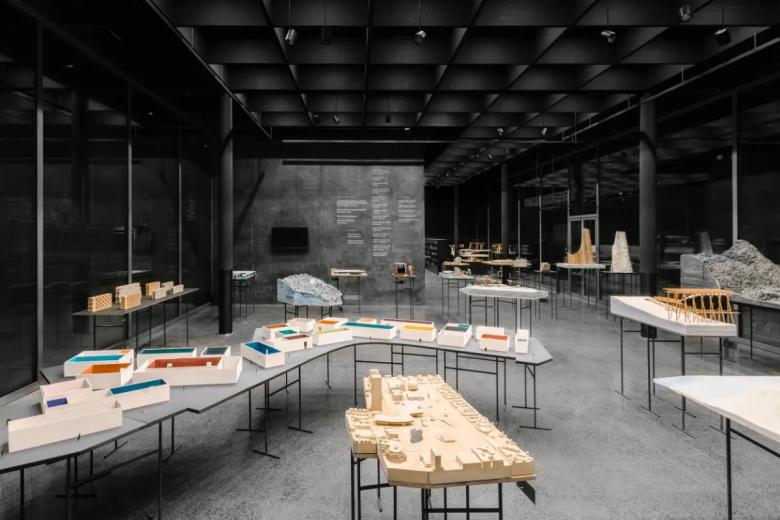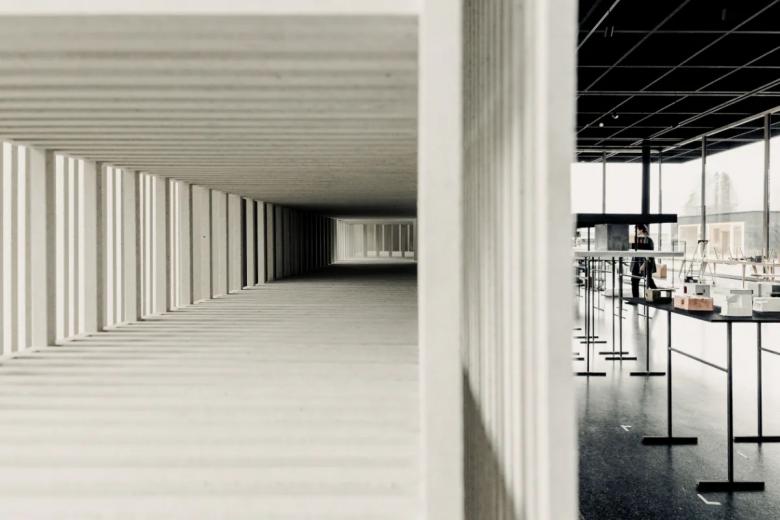An exhibition at Werkraum Bregenzerwald in the Austrian village of Andelsbuch presents some 40 architectural models from the Atelier Peter Zumthor. Through the models exhibited and the building itself, this show gives a tangible impression of his architectural approach.
These days, people spend a lot of time indoors. Long gone are the days of gathering and hunting outdoors, and few of us still work outside. And even in that case we need a protective place, a roof over our heads. The categories of space and body are closely intertwined, and one might even go so far as to interpret the house as a metaphor for the human body. It is hardly surprising that spaces also repeatedly play an important role in our dreams. Spaces are also always remembered places, and memory is linked to experience.
As Peter Zumthor leads us through Werkraum Bregenzerwald’s large exhibition space, where some 40 models from his studio are currently on display, he says that one of his early spatial experiences was that of churches. This comment can guide one’s view of the work of the Pritzker Prize laureate, but not as an absolute key to understanding it. Zumthor’s buildings are, after all, too diverse for a simplistic reading. Rather, this statement provides a clue that illuminates the aforementioned phenomenon of the spatial experience.
Just like the title of the show, Architectural Models from the Atelier Peter Zumthor: An exhibition about architecture born of craftsmanship conveys an idea of what visitors can learn here about Zumthor’s work. The exhibition is intended to be about spaces that are “conceived in terms of handcraft.” It is important that Peter Zumthor designed the exhibition space himself, because this renders the dialogue between the material presence of the exhibits and that of the space itself physically palpable.
The show marks Werkraum’s 10th anniversary and is complemented by a program of events. In the course of a guided tour and a subsequent discussion session, we had the opportunity to exchange a few words with the master himself. This added depth to the dialogue between the models and the space, further sharpening the portrait of the work of the architect from Haldenstein — although it must be said that my memories of visits to his buildings also played a strong part. No sooner did I stand in front of a model then very tangible memories of spatial experiences appeared: the ticking of the clock lapsed into silence for a moment. Because Zumthor’s architecture is always about more than visual impressions, my thoughts recalled, for example, the astonished gaze and feeling I had upon entering the tenuously elegant buildings of the Allmannajuvet Zinc Mine Museum in Norway. How I sat there on a chair of his design, eating soup and gazing into the rainy landscape. How I photographed a myriad of beautiful lichens and mosses along the way to the abandoned zinc mines and picked up an oddly shaped rock. Or of my first visit to the Kolumba Museum in Cologne, as an escape from the furniture trade fair. How naturally the sacred atmosphere, which unfolds without religious trappings, captivated me. How slow my breathing became and how quickly the swarm of people and design objects was forgotten. And how, on a later visit, even my daughter wanted to stay longer in the museum because she could peacefully doze a bit in the reading room on a chair — also designed by Zumthor.
Or else images emerge of Otobong Nkanga’s room-filling installations in Kunsthaus Bregenz, which transformed the museum into a microcosm of the Earth; and even the smell of clay on the top floor and the milky light of the spaces condense into an all-present now. Many other Zumthor moments come to me from some far corner of my brain — or maybe it’s more a form of cellular recollection. The cell: it is the smallest bodily and spatial unit. Body and space are also linguistically related. But how can all this occur at the mere sight of some models?
The significance of architectural models for Peter Zumthor’s work is considerable, and it is strongly tied to the material presence and physical dimensions of this material assemblage. Anything that is assembled requires making, and the craft of making things played an important biographical role in the development of an architect, who, as the son of a carpenter, initially followed in his father’s footsteps by undertaking an apprenticeship as a carpenter. This fact is more than an anecdote from the life of a well-known architect. It encapsulates the essence of Zumthor’s design stance, which springs from respect for matter and how it is crafted. So it comes as no surprise that over ten years ago, as an architect with a thriving international practice, he accepted the relatively small commission for the Werkraum Bregenzerwald building, a meeting place for skilled craftspeople from the region.
He had gotten to know and appreciate Vorarlberg’s craft culture years earlier, as the Bregenzer Kunsthaus was being built. The unexpected form of his design initially shocked the clients, we learn in a conversation between Zumthor, craftspeople, and a former managing director of the facility, but through dialogue they found a solution that satisfied everyone. Architecture does not originate (only) from the creative will of a human mind, but also from a process. This takes time (and money), which is something that many building projects can no longer afford for a wide variety of reasons — though profitability often plays a role of no small consequence. But that’s another matter.
Time is a precious resource. With this in mind, a parallel can perhaps be drawn between Zumthor’s architecture and the particular care with which he approaches the topic of materials. Matter does not fall from the sky; it emerges from processes of compression and consolidation that span centuries (in the case of wood) or even millennia (in the case of rocks). From this viewpoint, its integration is just another step in its transformation. The impact of matter is based on its temporal dimension. It has its own expression, which can manifest itself anew in the form of architecture. For instance, by revealing hidden aspects of its beauty in an unexpected alliance. Maintaining a balance between attention to the details of materials and the implicitness of its expression as a whole is an important trait of Zumthor’s creative production.
This special form of harmony also resonates (sound is also important to Zumthor!) in the elaborately designed models, which, strictly speaking, constitute works of their own. Nevertheless, they are mostly tools of work, intermediaries on the path to reality. Zumthor and his team use the models to analyze, for example, how daylight enters a space. In Zumthor’s architecture, light acquires an almost material quality; it is endowed with a language of its own. Light is the verb, while the walls are the nouns – subjects, but also objects. Matter is dynamically assembled, not statically inert. This may sound a little abstract, but the phenomenon is clearly legible especially in the models; we see the handcrafted artifact, the precision and care, but also the poetic and nonchalant juxtaposition of materials that are simultaneously governors and independent objects alike.
The models have yet another function: They are also instruments of communication when it comes to convincing clients about a project’s merits. This does not always work, or it fails to succeed in the face of various obstacles. The architect also divulges this as we tour the exhibition. One example is a hotel project in Chile, whose circular shape would have created a central communal outdoor space. The client himself was courageous, but people with a purely economic mindset advised him against the project, and thus it simply died. Zumthor says this without bitterness, but with an affectionate glance at the model, which at least survives now as a trace.
During a later discussion, he responds to a question from the audience about a dream project by saying he would really like to build a hotel in the mountains. The central role of landscape in his projects is evident — even in his urban buildings. The aim is always to embed the work in existing textures, to create a living assemblage. Visiting and studying a given place in detail is a prerequisite for the design. All aspects are important, Zumthor later says: the history and atmosphere of a territory. Equipped with this information, he responds to the specific environment. The fact that it is easy for him to find an answer, he says, is a gift. That is an exceptional statement for an architect, and one that adds another layer to the portrait that was previously spoken of. Paradoxically, it seems to be the gesture of acceptance that constitutes Zumthor’s fundamental stance toward design. Atmosphere can perhaps emerge — and there is much talk about this when writing about his architecture — when what is built also allows for expression of the vitality and fragility of matter. Maybe someone who approaches their work with serenity can do this more easily than anyone else. The architect, who recently celebrated his 80th birthday, is also looking serenely to the future. From now on, he wants to do only what’s good for him, he says, laughing.
This article originally appeared as “Zelluläre Architektur” on Swiss-Architects. Translation by Translation by David Koralek / ArchiTrans.




